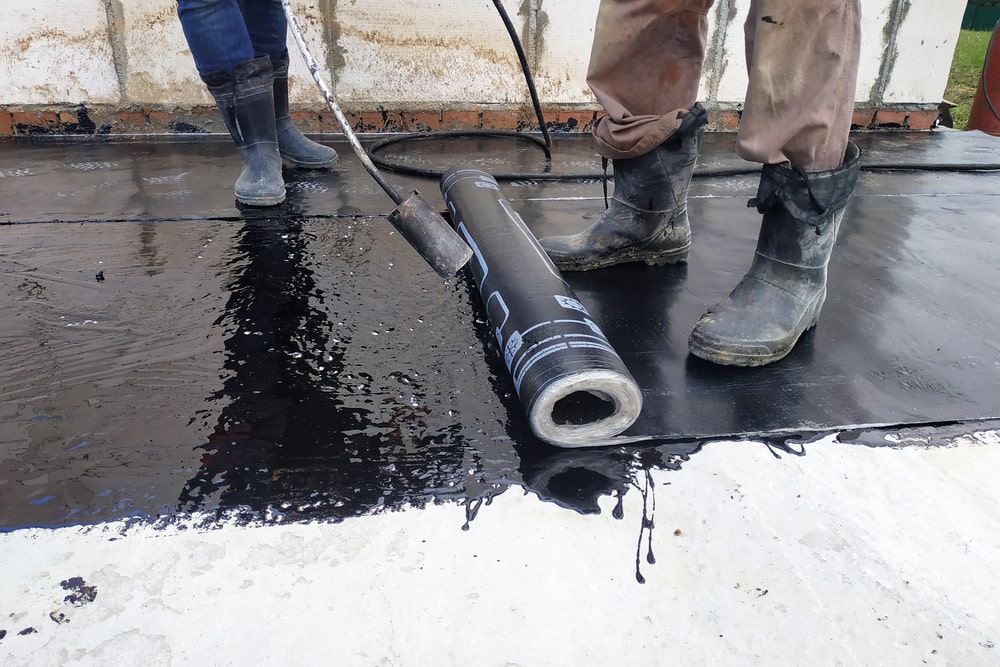If you’re a homeowner, there’s a fair chance you will need to repair your roof at some point in the not-so-distant future. While shingles are the most popular type of roofing, rolled roofing is another option that can be a practical choice for certain applications.

If you’re considering this type of roofing, continue reading to learn the basics that you need to know.
If you’re already familiar with the basics of rolled roofing, feel free to click here to learn more about installing rolled roofing on flat rooftops.
What is rolled roofing?
Rolled roofing is a common type of roofing material that is often used on residential, commercial, and industrial buildings.
Rolled roofing is made from a range of different materials, including asphalt, fiberglass, and polyester. The most common type of rolled roofing is asphalt roll roofing, which is made from multiple layers of asphalt-saturated felt.
Rolled roofing is distinguishable from other types of roofing by its method of installation. Rather than being installed in shingles or tiles, rolled roofing is installed in long strips that are then attached to the roof deck using nails or adhesive.
This method of installation makes rolled roofing much faster and easier to install than other types of roofing, making it a popular choice for buildings that need to be re-roofed quickly.
While rolled roofing does have some advantages, it also has some disadvantages. One disadvantage of rolled roofing is that it does not last as long as other types of roofing material, such as shingles or tiles. Asphalt roll roofing typically only has a lifespan of about 10 years, while fiberglass and polyester roll roofing can last up to 20 years.
How do you install rolled roofing and what tools do you need?
Homeowners can install rolled roofing with the help of some essential tools.
The tools required are a utility knife, a chalk line, a straight edge, prying bars, tin snips, and a hammer.
The first step is to calculate the size of the roof and then cut the rolled roofing to size.
Next, use the chalk line to mark where the rolled roofing will be installed. Once the rolled roofing is in place, use the straight edge to trim any excess material.
Finally, use the hammer to secure the rolled roofing in place. With these simple steps, average readers can easily install rolled roofing.
What are the most common mistakes people make when installing rolled roofing?
When it comes to rolled roofing, there are a few mistakes that are more common than others.
Here are some common mistakes people make regarding rolled roofing:
Mistake #1 — Failing to clean the surface
One of the most frequent mistakes is failing to properly clean the surface before installation. The surface should be free of debris, dust, and other particles that could interfere with the adhesion of the roofing material.
Mistake #2 — Using the wrong adhesive
Another common mistake is using an inappropriate adhesive. For example, some adhesives are not compatible with certain types of rolled roofing, which can lead to premature deterioration.
Mistake #3 — Not giving the adhesive enough time to cure
Finally, many people fail to allow enough time for the adhesive to cure before walking on the roof. This can cause the roofing material to shift or wrinkle, reducing its overall lifespan and effectiveness.
By avoiding these common mistakes, you can help ensure a successful rolled roofing installation.
How long does rolled roofing last on average?
On average, the overall lifespan of rolled roofing is around 10 to 20 years. The total lifespan of the roof will depend on the type and quality of the materials used and how well it was installed. However, it’s not uncommon for rolled roofing to last 30 to 40 years (or more with proper care).
One of the best ways to extend the life of your rolled roofing is to perform regular roof maintenance, such as clearing built-up debris and moss and ensuring that the gutters are clear.
Additionally, it’s important to have any leaks repaired promptly to prevent further damage. By taking these steps, you can ensure that your rolled roofing will last for many years to come.
What should you do if your rolled roof starts to leak or needs repairs?
If your rolled roof starts to leak or needs repairs, it is important to act quickly in order to avoid further damage.
However, before you attempt any repairs, it is important to make sure that you have the necessary tools and materials. For the average homeowner, we would recommend hiring a professional roofing company to do the job properly.
That being said, if you are comfortable making the repairs yourself, here are a few tips to get you started:
First, strip the shingles from your roof that are loose or show signs of physical damage.
Next, apply a layer of roofing cement to the edges of the shingles that you will be overlapping. Once the cement has dried, nails or staples can be used to secure the shingles in place.
Finally, apply another layer of roofing cement over the top of the seams and allow it to dry completely.
Image by Depositphotos





